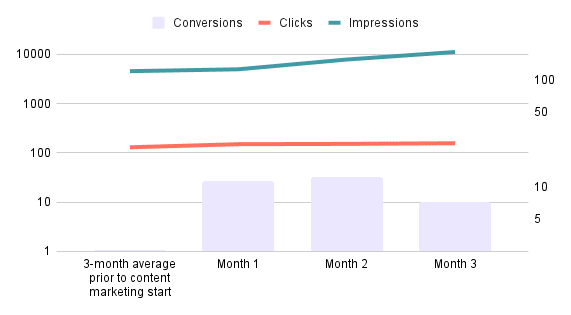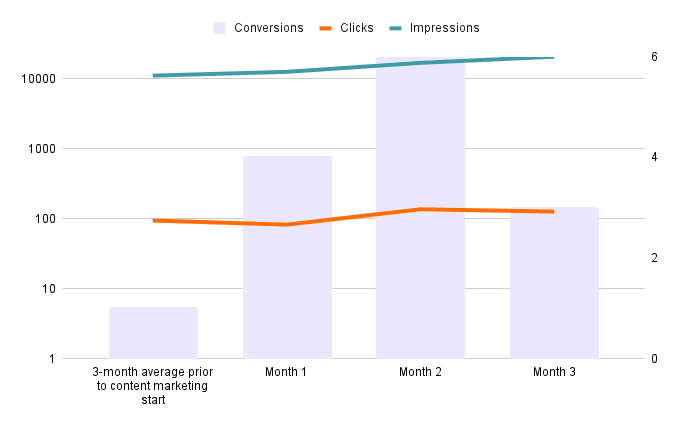The marketing community has been shouting “content is king” for many years now, but it can still be daunting to commit to a proper content strategy without knowing the outcome. So, how long does it take for content marketing to work?
START RIGHT
Setting yourself up for success
If you want your content strategy to achieve the best possible results you need to set yourself up for success.
You need to:
- Focus on quality content: Well-written and researched content will be more likely to rank and be linked to, as well as help build trust for your brand.
- Ensure you’re distributing your content appropriately.
- Write your content with SEO in mind but focus on answering the user’s question.
0-2 weeks
Indexing and crawling
When you first publish content, search engines like Google need to index and crawl your pages. This process typically begins within days but can take up to two weeks. If your technical SEO is solid, you’ll find this process is generally faster as it requires accurate sitemaps, and good website crawlability.
2-8 weeks
Initial rankings and adjustments
After indexing, your content starts to appear in search engine results. However, initial rankings usually fluctuate as Google assesses your content’s relevance and quality. You may see your content move up and down the rankings during this time, or see an initial surge followed by a slower decline if the content is particularly timely.
During this period you can start to gather data on what users are finding helpful about the content.
- Keep an eye on Search Console to see what queries are getting the most clicks.
- Are there any queries that the content is getting impressions for that have good volumes?
- Reoptimise and adjust the content if necessary.
3-6 Months
Consistent ranking and traffic growth
According to Ahrefs, it takes about 3-6 months for content to consistently rank in search results and start driving significant organic traffic.
We took a look at our own data of the clients we’ve helped over the last year or so to see how this held up with Ahref’s findings and found that on the whole, their claim rings true.
By three months following the implementation of your content strategy, you should be seeing some positive results. We dig a little deeper into this data further on, but first, let’s take a brief moment to discuss how you should be measuring this success.
"Within three months of starting a consistent content marketing strategy, all clients saw an uptick in clicks and impressions from Google as well as website conversions."
TRUST THE DATA
Measuring content performance
Click below to expand
The holy grail of metrics. If you’ve got your conversions set up correctly you should be able to determine if the content you’re producing is reaching the right audience.
EXAMPLE ONE
Quality and quantity
Let's compare the three months prior to the start of the content strategy with the first three months of consistent, quality content:
- Clicks from Google increased by 18%
- Impressions from Google increased by a whopping 75%
- The effect on conversions? A 300% increase.

EXAMPLE TWO
Clear down to level up
This client went through our favourite process – a full content audit, with some blogs being canned, and some being rewritten, whilst embarking on a new content strategy put together by ourselves. Each blog was researched, written, and optimised with the audience in mind.
Another great example of that three month window. Let's take a look at the stats:
- Clicks from Google up 22%
- Impressions in the search results increased by 50.7%
- The bottom line? Conversions up by 333%

EXAMPLE THREE
A cohesive and long-term strategy
So, we’ve ascertained that three months is a good period to look at to start seeing initial results. How about the longer term?
With this example, we were involved in the end-to-end process, so we were able to relaunch their site with a comprehensive content strategy. This means we can look at the data over a twelve month period and see what the true effect of a well-thought-out content strategy can have, supported by other areas of marketing such as more general website SEO, PR, and design.
In the graph below you can see the journey the website went through.
When we compare the first three months of the twelve month period with the last three months, we can clearly seen the progress even if we consider the dips:
- Clicks up by 57%
- Impressions from Google up 55%
- And a 106% conversion increase

These weren’t perfect upward trends – you can see from the graphs that things go up and down somewhat. And you can see that even three months in, although these stats sound impressive, often the biggest jumps have been in impressions. What’s the point if users aren’t clicking, you ask? Actually, this is a really positive sign, because it means that the site is ranking for more keywords that they weren’t before, or that keywords that weren’t ranking so highly are ranking higher and getting more eyeballs on them.
You should expect to see a trickle-down effect. If the hard work is maintained, the jump in impressions inevitably leads to higher clicks and better conversions. In fact, you can see in the stats above that the conversion increases were really positive already.
However, there are many variables that can influence this journey!
BECAUSE SEO COULD NEVER BE STRAIGHTFORWARD
Factors influencing content performance
From our examples above you can see that different brands grew at different rates. A 300% increase in conversions might only mean 5 more conversions than they had before, but if the brand is niche, or leads tend to result in large-scale deals, the actual impact on the bottom-line could be huge.
The first step to these results are of course producing consistent, quality content, as we’ve outlined above, but there are several factors that influence how quickly your content starts to work.
Click below to expand
Acquiring backlinks and social shares can accelerate content performance. Backlinko reports that “The number of referring domains is one of the most important ranking factors in Google’s algorithm.”
This is where having a PR strategy that is tied to your content strategy can really work wonders.
IN IT TO WIN IT
Creating quality content is a long-term investment
As you can see from our results above, initial results may start to be seen within the first month, but acceleration normally happens around the third month, with significant and sustained traffic growth typically occurring within 3-6 months if you stay the course. There are plenty of factors influencing the whys and hows, but it is impossible to deny that an informed and consistent content strategy will have a positive effect within 6 months.
Want to get ahead of the game?
If deep-diving into the data with us has finally convinced you to get stuck into your content marketing strategy, first of all, please let us know as you’ll make our day!
Once you’ve done that, we can get you started with some fantastic content strategy tips from our content lead, Victoria, or if you’re after some hands-on help, check out our content marketing services!
